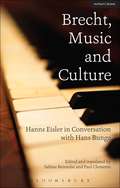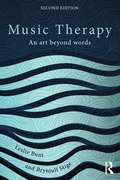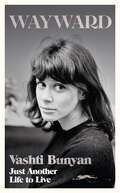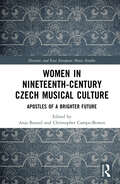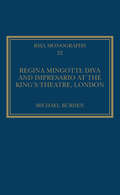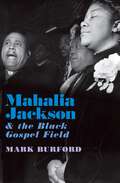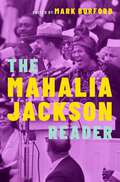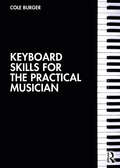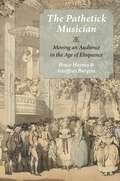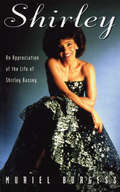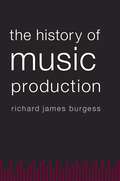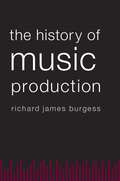- Table View
- List View
Oz and the Musical: Performing the American Fairy Tale
by Ryan BunchFrom the first stage production of The Wizard of Oz in 1902, to the classic MGM film (1939), to the musicals The Wiz (1975) and Wicked (2003), L. Frank Baum's children's novel The Wonderful Wizard of Oz (1900) has served as the basis for some of the most popular musicals on stage and screen. In this book, musical theater scholar Ryan Bunch draws on his personal experience as an Oz fan to explore how a story that has been hailed as "the American fairy tale" serves as a guide for thinking about the art form of the American musical and how both reveal American identity to be a utopian performance. Show by show, Bunch highlights the forms and conventions of each musical work as practiced in its time and context-such as the turn-of-the-century extravaganza, the classical Hollywood film musical, the Black Broadway musical of the 1970s, and the twenty-first-century mega-musical. He then shows how the journey of each show teaches participants and audiences something about how to act American within contested frameworks of race, gender, sexuality, age, and embodiment. Bunch also explores home theatricals, make-believe play, school musicals, Oz-themed environments, and community events as sites where the performance of the American fairy tale brings home and utopia into contact through the conventions of the musical. Using close readings of the various Oz shows, personal reflections, and interviews with fans, audiences, and performers, Bunch demonstrates how adapted Oz musicals imply both inclusions and exclusions in the performance of an American utopia.
Brecht, Music and Culture: Hanns Eisler in Conversation with Hans Bunge
by Hans Bunge Hanns Eisler Sabine Berendse Paul ClementsThe Austrian composer Hanns Eisler was Bertolt Brecht's closest friend and most politically committed collaborator. In these conversations with Hans Bunge which took place over a period of four years, from 1958 until his death in 1962, Eisler offers a compelling and absorbing account of his and Brecht's period of exile in Europe and the USA between 1933 and 1947, and of the quality of artistic, social and intellectual life in post-war East Germany. Brecht, Music and Culture includes a discussion of a number of Brecht's principal plays, including Life of Galileo and The Caucasian Chalk Circle, considers the place of music in Brecht's work and discusses the time that Brecht was brought before The House of Un-American Activities Committee. It includes lively accounts of Brecht's meetings with key cultural figures, including Arnold Schönberg, Charlie Chaplin and Thomas Mann, and offers throughout a sustained response to the question of the purpose of art in a time of political turmoil.Throughout the conversations, Eisler provides illuminating and original insights into Brecht's work and ideas and gives a highly entertaining first-hand account of his friend's personality and attitudes. First published in Germany in 1975, and now published in English for the first time, the conversations provide a fascinating account of the lives and work of two of the twentieth century's greatest artists.
Brecht, Music and Culture: Hanns Eisler in Conversation with Hans Bunge
by Hans Bunge Hanns Eisler Sabine Berendse Paul ClementsThe Austrian composer Hanns Eisler was Bertolt Brecht's closest friend and most politically committed collaborator. In these conversations with Hans Bunge which took place over a period of four years, from 1958 until his death in 1962, Eisler offers a compelling and absorbing account of his and Brecht's period of exile in Europe and the USA between 1933 and 1947, and of the quality of artistic, social and intellectual life in post-war East Germany. Brecht, Music and Culture includes a discussion of a number of Brecht's principal plays, including Life of Galileo and The Caucasian Chalk Circle, considers the place of music in Brecht's work and discusses the time that Brecht was brought before The House of Un-American Activities Committee. It includes lively accounts of Brecht's meetings with key cultural figures, including Arnold Schönberg, Charlie Chaplin and Thomas Mann, and offers throughout a sustained response to the question of the purpose of art in a time of political turmoil.Throughout the conversations, Eisler provides illuminating and original insights into Brecht's work and ideas and gives a highly entertaining first-hand account of his friend's personality and attitudes. First published in Germany in 1975, and now published in English for the first time, the conversations provide a fascinating account of the lives and work of two of the twentieth century's greatest artists.
The Handbook Of Music Therapy (PDF)
by Leslie Bunt Sarah HoskynsMusic therapists work with children and adults of all ages with wide-ranging health-care needs. This handbook traces the history of recent developments in music therapy and the range of current applications and outlines practical requirements for the work and some basic prerequisites for and philosophies of training. The Handbook of Music Therapy covers material encompassing clinical, practical and theoretical perspectives, and is divided into four main sections, including: * the recent evolution of music therapy as a paramedical discipline complementing the more traditional areas of child and adult health care * a clinical section including contributions from music therapy specialists in the fields of autism, adult learning disability, forensic psychiatry, neurology and dementia * a section on resources necessary to practise as a music therapist including musical illustrations and practical examples * a focus on issues pertinent to the life of the professional music therapist including job creation, supervision, further training and research. The Handbook of Music Therapy is illustrated with many case studies and clinical examples throughout, placed within a variety of different theoretical and philosophical perspectives. It will be invaluable to music therapists, other arts therapists and to clinicians such as speech and language therapists, psychotherapists, psychiatrists and social workers.
Music Therapy: An art beyond words (Ashgate Popular And Folk Music Ser.)
by Leslie Bunt Brynjulf StigeMusic therapy is recognised as being applicable to a wide range of healthcare and social contexts. Since the first edition of Music Therapy: An art beyond words, it has extended into areas of general medicine, mainstream education and community practice. This new edition revises the historical and theoretical perspectives and recognises the growing evidence and research base in contemporary music therapy. Leslie Bunt and Brynjulf Stige document the historical evolution of music therapy and place the practice within seven current perspectives: medical, behavioural, psychoanalytical, humanistic, transpersonal, culture-centred and music-centred. No single perspective, individual or group approach is privileged, although the focus on the use of sounds and music within therapeutic relationships remains central. Four chapters relate to areas of contemporary practice across different stages of the lifespan: child health, adolescent health, adult health and older adult health. All include case narratives and detailed examples underpinned by selected theoretical and research perspectives. The final two chapters of the book reflect on the evolution of the profession as a community resource and the emergence of music therapy as an academic discipline in its own right. A concise introduction to the current practice of music therapy around the world, Music Therapy: An art beyond words is an invaluable resource for professionals in music therapy and music education, those working in the psychological therapies, social work and other caring professions, and students at all levels.
Music Therapy: An art beyond words
by Leslie Bunt Brynjulf StigeMusic therapy is recognised as being applicable to a wide range of healthcare and social contexts. Since the first edition of Music Therapy: An art beyond words, it has extended into areas of general medicine, mainstream education and community practice. This new edition revises the historical and theoretical perspectives and recognises the growing evidence and research base in contemporary music therapy. Leslie Bunt and Brynjulf Stige document the historical evolution of music therapy and place the practice within seven current perspectives: medical, behavioural, psychoanalytical, humanistic, transpersonal, culture-centred and music-centred. No single perspective, individual or group approach is privileged, although the focus on the use of sounds and music within therapeutic relationships remains central. Four chapters relate to areas of contemporary practice across different stages of the lifespan: child health, adolescent health, adult health and older adult health. All include case narratives and detailed examples underpinned by selected theoretical and research perspectives. The final two chapters of the book reflect on the evolution of the profession as a community resource and the emergence of music therapy as an academic discipline in its own right. A concise introduction to the current practice of music therapy around the world, Music Therapy: An art beyond words is an invaluable resource for professionals in music therapy and music education, those working in the psychological therapies, social work and other caring professions, and students at all levels.
Wayward: Just Another Life to Live
by Vashti Bunyan'Magical and transporting . . . Wayward proves that Bunyan has lived the best possible life, on her own idiosyncratic terms'Maggie O'Farrell'A gorgeous account of outsiderness and survival: a map of how to live outside the boundaries and of striving for an authentic artistic life. A quietly defiant and moving work' Sinéad Gleeson'An epic in miniature . . . I loved - and lived - every sentence' Benjamin MyersIn 1968, Vashti Bunyan gave up everything and everybody she knew in London to take to the road with a horse, wagon, dog, guitar and her then partner. They made the long journey up to the Outer Hebrides in an odyssey of discovery and heartbreak, full of the joy of freedom and the trudge of everyday reality, sleeping in the woods, fighting freezing winters and homelessness. Along the way, Vashti wrote the songs that would lead to the recording of her 1970's album Just Another Diamond Day, the lilting lyrics and guitar conveying innocent wonder at the world around her, whilst disguising a deeper turmoil under the surface. From an unconventional childhood in post-war London, to a fledgling career in mid-sixties pop - recording a single written by Mick Jagger and Keith Richards - to the despair and failure to make any headway with her own songs, she rejected the music world altogether and left it all behind. After retreating to a musical wilderness for thirty years, the rediscovery of her recordings in 2000 brought Vashti a second chance to write, record and perform once more. One of the great hippie myths of the 1960s, Wayward, Just Another Life to Live, rewrites the narrative of a barefoot girl on the road to describe a life lived at full tilt from the first, revealing what it means to change course and her emotional struggle, learning to take back control of her own life.
Women in Nineteenth-Century Czech Musical Culture: Apostles of a Brighter Future (Slavonic and East European Music Studies)
by Anja Bunzel Christopher Campo-BowenThis volume focuses on the circumstances of women’s music-making in the vibrant and diverse environment of the Czech lands during the nineteenth century. It sheds light on little-known women musicians, while also considering more well-known works and composers from new woman-centric perspectives. It shows how the unique environment of Habsburg Central Europe, especially Bohemia and Lower Austria, intersects with gender to reveal hitherto unexplored networks that challenge the methodological nationalism of music studies as well as the discipline’s continued emphasis on singular canonical figures. The main areas of enquiry address aspects of performance and identity both within the Czech lands and abroad; women’s impact on social life with a view to different private, semiprivate, and public contexts and networks; and compositional aesthetics in musical works by and about women, analysed through the lens of piano works, song, choir music, and opera, always with the reception of these works in mind.
Women in Nineteenth-Century Czech Musical Culture: Apostles of a Brighter Future (Slavonic and East European Music Studies)
by Anja Bunzel Christopher Campo-BowenThis volume focuses on the circumstances of women’s music-making in the vibrant and diverse environment of the Czech lands during the nineteenth century. It sheds light on little-known women musicians, while also considering more well-known works and composers from new woman-centric perspectives. It shows how the unique environment of Habsburg Central Europe, especially Bohemia and Lower Austria, intersects with gender to reveal hitherto unexplored networks that challenge the methodological nationalism of music studies as well as the discipline’s continued emphasis on singular canonical figures. The main areas of enquiry address aspects of performance and identity both within the Czech lands and abroad; women’s impact on social life with a view to different private, semiprivate, and public contexts and networks; and compositional aesthetics in musical works by and about women, analysed through the lens of piano works, song, choir music, and opera, always with the reception of these works in mind.
Regina Mingotti: Diva and Impresario at the King's Theatre, London (Royal Musical Association Monographs)
by Michael BurdenRegina Mingotti was the first female impresario to run London's opera house. Born in Naples in 1722, she was the daughter of an Austrian diplomat, and had worked at Dresden under Hasse from 1747. Mingotti left Germany in 1752, and travelled to Madrid to sing at the Spanish court, where the opera was directed by the great castrato, Farinelli. It is not known quite how Francesco Vanneschi, the opera promoter, came to hire Mingotti, but in 1754 (travelling to England via Paris), she was announced as being engaged for the opera in London 'having been admired at Naples and other parts of Italy, by all the Connoisseurs, as much for the elegance of her voice as that of her features'. Michael Burden offers the first considered survey of Mingotti‘s London years, including material on Mingotti's publication activities, and the identification of the characters in the key satirical print 'The Idol'. Burden makes a significant contribution to the knowledge and understanding of eighteenth-century singers' careers and status, and discusses the management, the finance, the choice of repertory, and the pasticcio practice at The King's Theatre, Haymarket during the middle of the eighteenth century. Burden also argues that Mingotti‘s years with Farinelli influenced her understanding of drama, fed her appreciation of Metastasio, and were partly responsible for London labelling her a 'female Garrick'. The book includes the important publication of the complete texts of both of Mingotti's Appeals to the Publick, accounts of the squabble between Mingotti and Vanneschi, which shed light on the role a singer could play in the replacement of arias.
Regina Mingotti: Diva and Impresario at the King's Theatre, London
by Michael BurdenRegina Mingotti was the first female impresario to run London's opera house. Born in Naples in 1722, she was the daughter of an Austrian diplomat, and had worked at Dresden under Hasse from 1747. Mingotti left Germany in 1752, and travelled to Madrid to sing at the Spanish court, where the opera was directed by the great castrato, Farinelli. It is not known quite how Francesco Vanneschi, the opera promoter, came to hire Mingotti, but in 1754 (travelling to England via Paris), she was announced as being engaged for the opera in London 'having been admired at Naples and other parts of Italy, by all the Connoisseurs, as much for the elegance of her voice as that of her features'. Michael Burden offers the first considered survey of Mingotti‘s London years, including material on Mingotti's publication activities, and the identification of the characters in the key satirical print 'The Idol'. Burden makes a significant contribution to the knowledge and understanding of eighteenth-century singers' careers and status, and discusses the management, the finance, the choice of repertory, and the pasticcio practice at The King's Theatre, Haymarket during the middle of the eighteenth century. Burden also argues that Mingotti‘s years with Farinelli influenced her understanding of drama, fed her appreciation of Metastasio, and were partly responsible for London labelling her a 'female Garrick'. The book includes the important publication of the complete texts of both of Mingotti's Appeals to the Publick, accounts of the squabble between Mingotti and Vanneschi, which shed light on the role a singer could play in the replacement of arias.
Mahalia Jackson and the Black Gospel Field
by Mark BurfordNearly a half century after her death in 1972, Mahalia Jackson remains the most esteemed figure in black gospel music history. Born in the backstreets of New Orleans in 1911, Jackson during the Great Depression joined the Great Migration to Chicago, where she became an highly regarded church singer and, by the mid-fifties, a coveted recording artist for Apollo and Columbia Records, lauded as the "World's Greatest Gospel Singer." This "Louisiana Cinderella" narrative of Jackson's career during the decade following World War II carried important meanings for African Americans, though it remains a story half told. Jackson was gospel's first multi-mediated artist, with a nationally broadcast radio program, a Chicago-based television show, and early recordings that introduced straight-out-of-the-church black gospel to American and European audiences while also tapping the vogue for religious pop in the early Cold War. In some ways, Jackson's successes made her an exceptional case, though she is perhaps best understood as part of broader developments in the black gospel field. Built upon foundations laid by pioneering Chicago organizers in the 1930s, black gospel singing, with Jackson as its most visible representative, began to circulate in novel ways as a form of popular culture in the 1940s and 1950s, its practitioners accruing prestige not only through devout integrity but also from their charismatic artistry, public recognition, and pop-cultural cachet. These years also saw shifting strategies in the black freedom struggle that gave new cultural-political significance to African American vernacular culture. The first book on Jackson in 25 years, Mahalia Jackson and the Black Gospel Field draws on a trove of previously unexamined archival sources that illuminate Jackson's childhood in New Orleans and her negotiation of parallel careers as a singing Baptist evangelist and a mass media entertainer, documenting the unfolding material and symbolic influence of Jackson and black gospel music in postwar American society.
Mahalia Jackson and the Black Gospel Field
by Mark BurfordNearly a half century after her death in 1972, Mahalia Jackson remains the most esteemed figure in black gospel music history. Born in the backstreets of New Orleans in 1911, Jackson during the Great Depression joined the Great Migration to Chicago, where she became an highly regarded church singer and, by the mid-fifties, a coveted recording artist for Apollo and Columbia Records, lauded as the "World's Greatest Gospel Singer." This "Louisiana Cinderella" narrative of Jackson's career during the decade following World War II carried important meanings for African Americans, though it remains a story half told. Jackson was gospel's first multi-mediated artist, with a nationally broadcast radio program, a Chicago-based television show, and early recordings that introduced straight-out-of-the-church black gospel to American and European audiences while also tapping the vogue for religious pop in the early Cold War. In some ways, Jackson's successes made her an exceptional case, though she is perhaps best understood as part of broader developments in the black gospel field. Built upon foundations laid by pioneering Chicago organizers in the 1930s, black gospel singing, with Jackson as its most visible representative, began to circulate in novel ways as a form of popular culture in the 1940s and 1950s, its practitioners accruing prestige not only through devout integrity but also from their charismatic artistry, public recognition, and pop-cultural cachet. These years also saw shifting strategies in the black freedom struggle that gave new cultural-political significance to African American vernacular culture. The first book on Jackson in 25 years, Mahalia Jackson and the Black Gospel Field draws on a trove of previously unexamined archival sources that illuminate Jackson's childhood in New Orleans and her negotiation of parallel careers as a singing Baptist evangelist and a mass media entertainer, documenting the unfolding material and symbolic influence of Jackson and black gospel music in postwar American society.
The Mahalia Jackson Reader (Readers on American Musicians Series)
by Mark BurfordBorn in New Orleans before migrating to Chicago, Mahalia Jackson (1911-72) is undoubtedly the most widely known black gospel singer, having achieved fame among African American communities in the 1940s then finding a wide audience among non-black U.S. and international audiences after she signed with major label Columbia Records in 1954. The newest entry in OUP's celebrated Readers on American Musicians series,ÂThe Mahalia Jackson ReaderÂplaces Jackson's musical performances and their reception against key changes in 20th-century America, changes that include transformations of the recorded music industry, the increasing visibility of the civil rights movement, a florescence of Cold War-era religiosity, and an explosion of popularity of black gospel music itself. Jackson's career combines parallel tracks as a black church singer and as a national pop celebrity, and makes her one of the most complex and important black artists of the postwar decades. Gospel is a particularly challenging genre to study because of the paucity of sources. BecauseÂof Jackson's celebrity, there is more substantial coverage of her life and work than other gospel artists, but Jackson scholarship is still largely dependent on trade biographies from the 1970s for source material. For this reader, Mark Burford has gone beyond the standard biographies and has drawn from extensive archival research, including in the volume interview transcripts and the largely-untouched papers of Jackson's associate Bill Russell, who kept a journal tracking Jackson's activities from 1951 to 1955. The new sources - in particular Russell's notes - uniquely enable an assessment of the reciprocal relationship between the two careers Jackson pursued, essentially simultaneously: as an in-demand church singer in Chicago, and as a media star for a major network and recording label.
Keyboard Skills for the Practical Musician
by Cole BurgerKeyboard Skills for the Practical Musician provides undergraduate music majors in class piano courses with the techniques and fundamentals they need to flourish into independent, versatile musicians who play with confidence and sensitivity. Organized by skill (rather than level), the topics sequenced in this textbook offer endless flexibility for instructors while guiding students in a step-by-step approach through the development of essential keyboard skills ? such as reading, harmonization, improvisation, and accompaniment ? supporting concepts learned in music theory, ear training, private lessons, methods classes, and ensemble courses. One can draw from many sections of the book in any given class or semester, covering a wide range of piano skills that foster abilities frequently used in a myriad of musical professions.Features: • Over 400 sightreading, transposition, and score reading examples, along with 125 harmonization Melodies• Project assignments that promote independent learning, expose students to new musical styles, and encourage collaboration • A concluding Repertoire section with lists of solo and duet music, 10 ensemble arrangements, 6 duets, and additional pieces from the Baroque, Classical, Romantic, and Post-Romantic eras • Music examples include numerous works by composers from marginalized backgrounds and from global folk music• No prior piano background knowledge neededExplaining the core elements of keyboard learning in an accessible and responsive format while accentuating the importance of learning how to learn, Keyboard Skills for the Practical Musician offers an essential resource for all class piano students and instructors.
Keyboard Skills for the Practical Musician
by Cole BurgerKeyboard Skills for the Practical Musician provides undergraduate music majors in class piano courses with the techniques and fundamentals they need to flourish into independent, versatile musicians who play with confidence and sensitivity. Organized by skill (rather than level), the topics sequenced in this textbook offer endless flexibility for instructors while guiding students in a step-by-step approach through the development of essential keyboard skills ? such as reading, harmonization, improvisation, and accompaniment ? supporting concepts learned in music theory, ear training, private lessons, methods classes, and ensemble courses. One can draw from many sections of the book in any given class or semester, covering a wide range of piano skills that foster abilities frequently used in a myriad of musical professions.Features: • Over 400 sightreading, transposition, and score reading examples, along with 125 harmonization Melodies• Project assignments that promote independent learning, expose students to new musical styles, and encourage collaboration • A concluding Repertoire section with lists of solo and duet music, 10 ensemble arrangements, 6 duets, and additional pieces from the Baroque, Classical, Romantic, and Post-Romantic eras • Music examples include numerous works by composers from marginalized backgrounds and from global folk music• No prior piano background knowledge neededExplaining the core elements of keyboard learning in an accessible and responsive format while accentuating the importance of learning how to learn, Keyboard Skills for the Practical Musician offers an essential resource for all class piano students and instructors.
The Pathetick Musician: Moving an Audience in the Age of Eloquence
by Geoffrey Burgess Bruce HaynesWhat is rhetorical music? In The Pathetick Musician, Bruce Haynes and Geoffrey Burgess illustrate the vital place of rhetoric and eloquent expression in the creation and performance of Baroque music. Through engaging explorations of the cantatas of J.S. Bach, the authors explode the conventional notion of historical authenticity in music, proposing adventurous new directions to reinvigorate the performance of early music in the modern setting. Along the way, Haynes and Burgess investigate intersections between music and oratory, dance, gesture, poetry, painting and sculpture, and offer insights into figural elaboration, articulation, nuance and temporality. Aimed primarily at performers of Baroque music, the book situates the study of performance practice in a broader cultural context, and as much as an invaluable resource for advanced study, it contains a wealth of information that pertains directly to anyone working in the field of early music. Based on a draft sketched by celebrated Baroque oboist and early music scholar Bruce Haynes before his death in 2011, The Pathetick Musician is the fruit of the combined wisdom of two musicians renowned equally for their contributions as performers and scholars. Drawing on an impressive array of Classical treatises on oratory, musical autographs and performance accounts, it is an essential companion to Haynes' controversial The End of Early Music. Geoffrey Burgess has taken up the broader claims of Haynes' philosophy to create a practical, accessible text that will be stimulating for all musicians interested in the rediscovery of early music. With copious musical examples, contemporaneous works of art, and a companion website with supplementary audio recordings, The Pathetick Musician is an invaluable resource for all interested in exploring new expressive possibilities in the performance and study of Baroque music.
Shirley: An Appreciation Of The Life Of Shirley Bassey
by Muriel BurgessShirley Bassey is one of the all-time greats of the entertainment business. She has sold more records than any other British female singer and still commands massive audiences around the world. Now, after a career spanning decades, her life story can be told: the story of a triumph over enough tragedies to last several lifetimes. The personal hardships that have fuelled the emotionalism of her songs have never before been revealed. Here her poverty-stricken childhood in Wales is detailed: how her mother struggled to bring up seven children on Income Support after their Nigerian father was deported; how she worked in a saucepan factory when her first struggles for stardom were halted by her pregnancy at sixteen. Shirley had a series of tortured loves: she married a homosexual Cockney who died of an overdose; she had a highly publicised affair with actor Peter Finch; and her second marriage, to an Italian, also failed. The shocking death of her second daughter, Samantha, just before her 21st birthday caused Shirley to lose her voice for nearly a year. Behind the showbiz glamour and consummate professionalism lies a fiercely resilient and independent woman.
The History of Music Production
by Richard James BurgessIn The History of Music Production, Richard James Burgess draws on his experience as a producer, musician, and author. Beginning in 1860 with the first known recording of an acoustic sound and moving forward chronologically, Burgess charts the highs and lows of the industry throughout the decades and concludes with a discussion on the present state of music production. Throughout, he tells the story of the music producer as both artist and professional, including biographical sketches of key figures in the history of the industry, including Fred Gaisberg, Phil Spector, and Dr. Dre. Burgess argues that while technology has defined the nature of music production, the drive toward greater control over the process, end result, and overall artistry come from producers. The result is a deeply knowledgeable book that sketches a critical path in the evolution of the field, and analyzes the impact that recording and disseminative technologies have had on music production. A key and handy reference book for students and scholars alike, it stands as an ideal companion to Burgess's noted, multi-edition book The Art of Music Production.
The History of Music Production
by Richard James BurgessIn The History of Music Production, Richard James Burgess draws on his experience as a producer, musician, and author. Beginning in 1860 with the first known recording of an acoustic sound and moving forward chronologically, Burgess charts the highs and lows of the industry throughout the decades and concludes with a discussion on the present state of music production. Throughout, he tells the story of the music producer as both artist and professional, including biographical sketches of key figures in the history of the industry, including Fred Gaisberg, Phil Spector, and Dr. Dre. Burgess argues that while technology has defined the nature of music production, the drive toward greater control over the process, end result, and overall artistry come from producers. The result is a deeply knowledgeable book that sketches a critical path in the evolution of the field, and analyzes the impact that recording and disseminative technologies have had on music production. A key and handy reference book for students and scholars alike, it stands as an ideal companion to Burgess's noted, multi-edition book The Art of Music Production.
The History Of Music Production (PDF)
by Richard James BurgessRichard James Burgess draws on his experience as a producer, a musician, and an author in this history of recorded music, which focuses on the development of music production as both art form and profession.
Wild colonial boys: A Belfast punk story
by Thomas Paul BurgessRuefrex were one of Northern Ireland’s most popular and uncompromising punk rock bands.Emerging from the Belfast street-gang culture of the late-1970s, the group, inspired by The Clash, enjoyed a turbulent, decade-long career. They played for millions on CNN and Channel 4, toured with The Pogues and recorded the controversial ‘The Wild Colonial Boy’, which attacked American donations to Northern Irish terrorist organisations.Throughout it all, founder member, songwriter and spokesperson Thomas Paul Burgess ensured the band remained faithful to their Protestant, working-class origins. This candid memoir takes us on a journey from the streets of Belfast to encounters with U2, Shane MacGowan, The Cure, The Fall and Seamus Heaney.From strife-torn 1970s Belfast to bohemian London, Wild colonial boys tells the story of a punk band who refused to give up and stayed true to their punk roots.
Wild colonial boys: A Belfast punk story
by Thomas Paul BurgessRuefrex were one of Northern Ireland’s most popular and uncompromising punk rock bands.Emerging from the Belfast street-gang culture of the late-1970s, the group, inspired by The Clash, enjoyed a turbulent, decade-long career. They played for millions on CNN and Channel 4, toured with The Pogues and recorded the controversial ‘The Wild Colonial Boy’, which attacked American donations to Northern Irish terrorist organisations.Throughout it all, founder member, songwriter and spokesperson Thomas Paul Burgess ensured the band remained faithful to their Protestant, working-class origins. This candid memoir takes us on a journey from the streets of Belfast to encounters with U2, Shane MacGowan, The Cure, The Fall and Seamus Heaney.From strife-torn 1970s Belfast to bohemian London, Wild colonial boys tells the story of a punk band who refused to give up and stayed true to their punk roots.
One Two Another: Line By Line: Lyrics from The Charlatans, Solo and Beyond
by Tim BurgessA Rough Trade Book of the Year 'From lists to experiences and stories, there are no rules. A good song is a good song whoever writes it and however the writing happens.'Tim Burgess is a musical maverick and legend. Over the past three decades, he has cultivated a lyrical style that is equal parts searing, elusive and raw. Brimming with nods to an eclectic array of influences, from French chanson to East Coast rap, his words provide vivid snapshots of modern life, its highs and lows, and the things we do to get by.For the first time Tim's collected lyrics are accompanied by his revealing commentary, featuring backstage anecdotes, advice on how to conjure up the music muse, poignant reflections - and insight into a very idiosyncratic songwriting process.One Two Another chronicles the evolution of Tim's songwriting and reveals the method behind the madness.'Tim Burgess is a crusader and vinyl's epic voyager. He knows why pop's art, a culture and a cure. Learn and listen. He knows good things' Johnny Marr'You can't feel blue around Tim. He makes you feel happy, not just about music but about life. Even the most cynical of souls (mine) become infected by his gorgeous energy. Plus he gives good vinyl' Sharon Horgan

